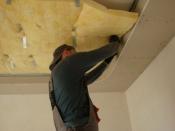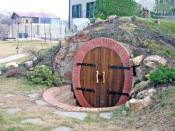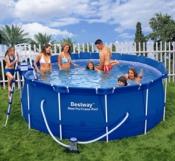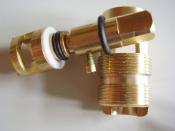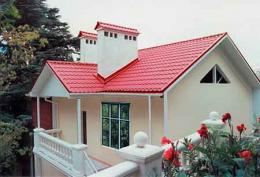Search
Login
Types of metal, we understand the types of metal, its disadvantages and advantages
One of the first places in the ranking of the most popular roofing materials is metal. She is at such a high place in the ranking for a reason. Choosing it as a material for covering the roof in his own house, the owner will be convinced of the sufficient strength of the material, its non-susceptibility to the effects of natural phenomena, he will be surprised at the wide choice of the proposed colors, he will be able to try installing it with his own hands and be convinced of the ease of installation, light weight and long service life . A metal tile is such a material that will ideally look on the roof of a bathhouse, a cottage, and any suburban buildings.
Content:
- What is a metal tile video
- Base Material
- Tile protective coatings
- Metal - profile views
- Metal tile - dimensions
- How to choose a metal tile video
- Disadvantages of metal roofing and methods for their elimination video
What is a metal tile

Metal tile is one of the most popular roofing materials of our time. It is made as follows: on the so-called base made of a metal profile, several protective layers of polymer materials are applied. Namely - on a sheet steel a zinc layer, then a passivating layer, on it a primer layer and, last but not least, a colored polymer coating.
In the production of metal tiles, as a basis, aluminum sheet, galvanized iron or copper is most often used as the basis.
With its external shape, this material is very similar to ordinary tiles made of clay. But in contrast to the overlap made of natural tiles, roofing material or slate, the roof of the metal tile has a more neat appearance that wins much more compared to the others.
Due to the peculiarities of the structure, it will last up to 50 years without replacement. Of course, the duration of its service depends on the degree of impact and environmental aggressiveness and the quality of the polymer coatings used in the manufacture of tiles, depending on the materials used for the manufacture of prices, the types of metal tiles are formed.
In order to make sure of its strength it is enough to know that sheets with a thickness of up to 0.5 cm can easily withstand the weight of an adult or a mass of snow up to 250 kg per sq / m.
Experts advise to roof metal roofs, the slope of the ramps which have at least 14 degrees with respect to the horizon.
Base Material

As already mentioned above, the metal sheet is the basis for the metal tile. Today, several of its types are produced - using galvanized iron up to 0.5 cm thick, non-ferrous metal alloys and aluminum as a basis.
Basically, to cover the roof, they use a material with a galvanized iron base, because it costs much less than other types currently produced. Products with a base made of copper, aluminum, non-ferrous metal alloys are certainly much more expensive, but they have a longer service life.
Tile protective coatings

To increase the service life, metal sheets are coated with special layers of protection. One of the most optimal budget options is considered to be a polyester coating. However, despite the low cost and far from small selection of colors, this coating is not resistant to fading and various damage. But the low price makes this product a frequently bought building material.
A denser coating is made of matte polyester. A product with such a protective layer is very similar to ordinary ceramic tiles. Its service life automatically increases due to a denser layer of protection.
Pural - This type of protection is based on polyurethane. A distinctive feature of this coating is the absence of deformation under the influence of sunlight, in other words, due to this coating, the original color is retained for a long time. A metal tile with such a coating is not much more expensive than with ordinary polyester.
PVDF is a protective coating based on polyvinyl fluoride. It is applied in a thin layer, but despite this it is considered one of the most stable. It has a fairly long service life and, accordingly, a high price.
Plastisol - is applied in a relatively thick layer, but it has excellent protection against various injuries.
Metal - profile views
All existing types of metal tiles differ in both the base material and the coating for protection, and the profile height and shape. Of course, reliability and durability depend directly on the thickness of the profile. This is especially important for mounting roofs in areas with possible heavy snowfall. Accordingly, the thicker the profile, the more reliable and stronger the roof will be.

Types of waves of metal tile differ in two parameters: height and pitch. A wave with a height of 23-35 mm and a pitch of 350 mm is considered standard.
Most often on sale there is a profile with a thickness of 40-45 mm. The most popular form for this profile is S-shaped. Monterrey and Andalusia have a similar shape.
Still there are such fairly popular profiles as the Joker, Shanghai, Banga, Modern. The Cascade metal tile is no less in demand - it is attractive in its original profile shape. Of course, they are all different from each other in pitch and height, and it is on them that the appearance of the roof depends.
Metal tile - dimensions

There is more than one metal tile manufacturing company on the construction market, the sizes of the products they manufacture are also very diverse - from 1100 mm to 1200 mm wide, from 800 mm to 8 m long (the length can also vary depending on the customer’s desire). Today, manufacturing companies are popular with the product slicing service according to the declared size of the customer.

The thickness of the material also does not have clear numbers. It ranges from 0.45 mm to 0.5 mm. Naturally, the weight of the product is also different. It directly depends on the material used for the substrate and the type of coating for protection. Weight can be from 3.6 kg to 7 kg per square meter. These indicators are used when calculating the rafter system for a metal tile.
How to choose a metal tile

When choosing material for covering the roof, you need to carefully study its appearance, polymer coating and metal density.
The color range of metal tiles is quite wide, that is, the color can be chosen based on your tastes, or by combining with the general color scheme of the entire site or with the design of neighboring buildings. Basically, they buy those colors that are closest to the natural shades of ceramic tiles. Often the colors of the green tint range are very popular, which provide the roof with color harmony with the surrounding greenery of nature. When choosing a roof covering for other colors, you need to be careful so that your house does not turn out too colorful.

Experts advise choosing the type of metal tile based on the climatic conditions of the area. And if in your region during the winter period a large amount of snow falls, buy material with a metal base and at least 0.5 mm thick.
The type of polymer protective coating must be selected based on the intensity of atmospheric phenomena in the area. For example, if your personal plot is located in the middle lane, where it is not too hot in the summer and there are no strong prolonged frosts in the winter, then a tile with a protective coating of polyester is quite suitable for you, which in turn will make it possible to save money when buying.
In the case when you cover the roof in a house located in an area with strong temperature fluctuations or near the sea, where there is a large amount of sea salt vapor in the air, that is, with a high content of aggressive substances for building materials, you need to select a higher degree of protection. In such cases, you need to pay attention to the material with protection from pural, polyvinyl fluoride or plastoisol.
As with the purchase of any other product, check out the quality certificate for this product. This acquaintance will make it possible to buy quality goods from a reliable manufacturer and not waste money.
We hope that the information you received about the types of metal roof tiles will help you buy quality and suitable material for use in the conditions of your area.
Disadvantages of metal roofing and methods for their elimination

Unfortunately, there is no material that would not have any drawbacks at this point in time; metal roofing also has them. First of all, this is the possibility of condensation settling on a metal surface with a significant temperature difference indoors and outdoors. The constant repetition of this phenomenon can lead to corrosive processes. For this reason, you should follow the recommendations for laying layers of a subroofing film, which is a vapor barrier or a hydrobarrier.
At the stage of laying the material, a serious drawback may be its increased waste, especially if the roof of the house has a complex geometry.
Metal is a noisy material, particularly during rain. To protect the residents of the house from excessive sounds, it is enough to lay a layer of mineral wool insulation during the installation of the roof, in addition to the layer of vapor and waterproofing. Thus, all the shortcomings of the metal roofing are eliminated quite simply.
